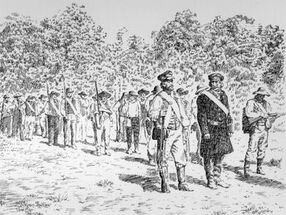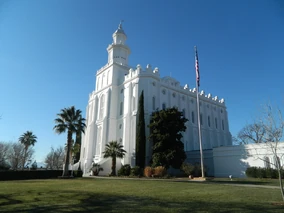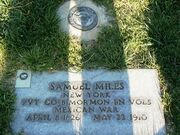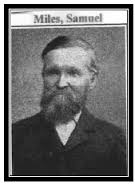Pvt Samuel Miles II was born 8 April 1826 in Attica, Wyoming County, New York to Samuel Miles (1779-1847) and Prudence Marks (1795-1852) and died 22 May 1910 St. George, Washington County, Utah of unspecified causes. He married Hannah Miranda Colborn (1830-1911) 6 September 1849 .
Biography[]
Veteran of the Mexican-American War of 1846-1848. He would later serve in the LDS Church as High Councelor for the St George Utah Stake.
His uncle was William Marks, 1st LDS Stake President of early Nauvoo.
Early Life[]
The son of Samuel Miles and Prudence Marks, and was born in Attica, Wyoming Co, New York, April 8, 1826. In the winter of 1833-34 Elders Orson Whitley Pratt (1811-1881) and John Murdock (1792-1871) preached the gospel in Cattaraugus county. N. Y., and the Miles family were among those who heard and believed.
Missouri Migration[]
In 1836 the Miles family followed the body of Mormon Saints to Caldwell County, MO and were there witnesses to many of the historic events of that period (see his autobiography below).
School Teacher[]
By 1839, the Mormons were forced to move enmasse to Nauvoo, Illinois. By age 15 (1841), he was attending the University of Nauvoo and then soon afterwards, young Samuel was teaching primary school in both Nauvoo and also in Eastern Hancock Co.
Mormon Battalion[]

Participant in the march of The Mormon Battalion. This unit of the US Army served in the Mexican-American War and was the only religiously based infantry unit ever created by Presidential order. It consisted of nearly 500 men recruited exclusively from The Church of Jesus Christ of Latter-day Saints (commonly called the Mormons). They undertook the longest infantry march in U.S. military history (as of 1847) and in the process marked out and creating the first continuous wagon road to California which linked the future states of New Mexico, Arizona, and California to the United States. Most members served an initial 12 month term (Jul 1846- Jul 1847) with some members re-enlisting for an additional 12 months afterwards.
In 1846 Samuel joined with Company B of The Mormon Battalion and completed the entire march with his company to Los Angeles. He kept a detailed journal of daily life in the battalion. He finally arrived in the Salt Lake Valley and was married there the following year.
Church Callings[]

Samuel Miles worked extensively inside the St. George Utah Temple.
In 1857, Samuel served a proselyting mission to the area of Stockton CA. His family was called in 1862 to head south to help settle the Washington County, Utah area where he was active in his profession of teaching school. Here he was called as a High Councilor in the St. George Stake and Stake Superintendent of Sunday Schools. His family settled on a farm at the Price/Heberville area, just five miles from St George. He was very active in the St. George Utah Temple after its completion in 1877.
Heberville Settlement[]
Heberville was a short-lived experimental community of pioneers sent to the Dixie area to further experiment with the growing of cotton in the Dixie area. Cotton had been grown successfully at both Santa Clara and Washington and the church authorities felt that further tests were needed before they sent a large colonizing group to the area.
Joseph Horne led this company of men came in January of 1858 stopping at Harmony on their way south. John D. Lee thought the best place to farm was where the Santa Clara and Virgin rivers came together but the company felt less labor would be needed if they cultivate the valley just south of the junction. The men were able to build a dam of gravel and brush seventy feet long and ten to fifteen feet high across the Virgin River to get irrigation water.
Heberville was abandoned by all concerned in about 1867.
Autobiographical Life Sketch[]

Gravestone of Pvt Samuel Miles - St George City Cemetery - Plot: B_6_12_5_NH
Brother Miles writes in a life sketch:
"In the fall of 1835, together with my father's family, I started for the gathering place of the Saints in Missouri. We passed through Kirtland, Ohio, and camped for the winter at New Portage. There I was baptized by Solomon Warner, in April, 1836. We continued our journey in May, 1836, and arrived at Caldwell county, Missouri, where we settled near Far West. Many times have I rejoiced in listening to the Prophet's preaching in the public assemblies of the Saints. I was present July, 1838, when the cornerstones of the Temple were laid at Far West. The acts of the mob militia, ordered out by Gov. Boggs, in devastating our fields, destroying our crops, and abusing peaceful-minded and aged citizens, their hideous yells and cries, when they had the Prophet Joseph Smith and other brethren as prisoners in their camp near our house, are all indelibly impressed upon my mind; this, with the subsequent expulsion of the Saints from Missouri, together with the suffering endured before we reached Illinois, forms a chapter in my life never to be forgotten.
Our family lived in Lima, Adams county, Ill., till the fall of 1839, when we settled in Commerce, (later Nauvoo). I had the privilege of attending the University of Nauvoo and receiving instruction from Prof. Orson Pratt, Lorin Farr and others. At the age of fifteen I taught a primary school in Nauvoo, and later taught school in the eastern part of Hancock county. After the martyrdom of Joseph and Hyrum Smith, I rode 50 miles to attend the funeral, passing through Carthage on the way.I also took an active part in defending the city of Nauvoo against the mobs. In June, 1846, I left Nauvoo for the west, and on reaching Council Bluffs, Iowa, I enlisted in the famous Mormon Battalion. My experiences from July 16, 1846, to July 16, 1847, when I was discharged at Los Angeles, Cal., forms a notable year in my life. I kept a daily journal, detailing the hardships and trials endured. Together with other discharged soldiers, I started for Salt Lake City, but we received instructions from Pres. Brigham Young to remain in California for a while longer.
I finally arrived in Great Salt Lake valley, Sept. 6, 1848, and located in Salt Lake City. I married Hannah M. Colborn, Sept. 6, 1849, and the same year I sent east for my mother to come to the Valley, my father had died during my absence. I was ordained a Seventy Jan. 18, 1851, and in 1857 I filled a mission to California, laboring mostly in the city of Stockton and vicinity. In October, 1862, I went south and settled in St. George, Washington county, where I followed school [p.537] teaching. May 12, 1867, I was ordained a High Priest by Apostle Erastus Snow and set apart as a High Councilor in the St. George Stake, and also as Stake superintendent of Sunday schools. In the same year (1867) I moved my family to Price (formerly Heberville), five miles from St. George, where I have followed farming for a livelihood. I have had the privilege of performing considerable Temple work for my relatives who have passed beyond the veil."
Children
| Name | Birth | Death | Joined with |
| William Gustavus Miles (1851-1927) | |||
| Samuel Miles (1853-1921) | |||
| Thomas Colburn Miles (1856-1923) | |||
| Ira Miles (1859-1910) | |||
| John Talmai Miles (1862-1920) | |||
| Franklin Godbe Miles (1865-1932) | |||
| James Edwin Miles (1867-1869) | |||
| Charles Henry Miles (1870-1940) | |||
| Hannah Miranda Miles (1874-1963) | |||
Siblings[]
| Name | Birth | Death | Joined with |
| Samuel Miles (1826-1910) | 8 April 1826 Attica, Wyoming County, New York | 22 May 1910 St. George, Washington County, Utah | Hannah Miranda Colborn (1830-1911) |
| William Marks Miles (1828-1897) | |||
| Sarah Simonds Miles (1831-1904) | |||
| Orson Pratt Miles (1834-1896) | |||
| Gustav Miles (1835-) | |||
